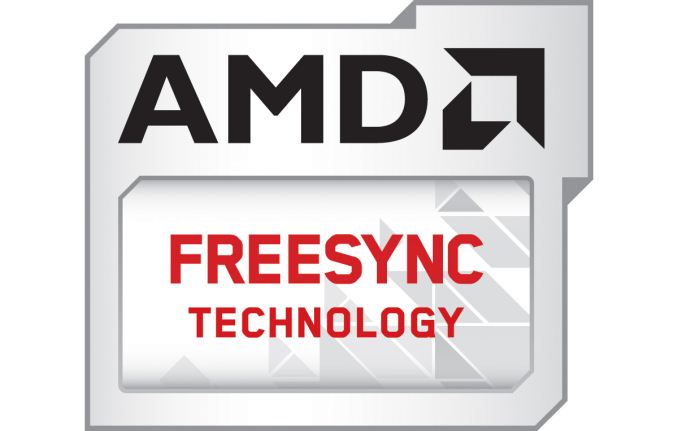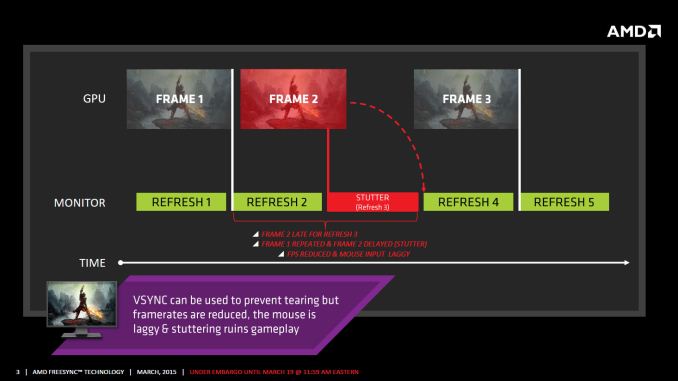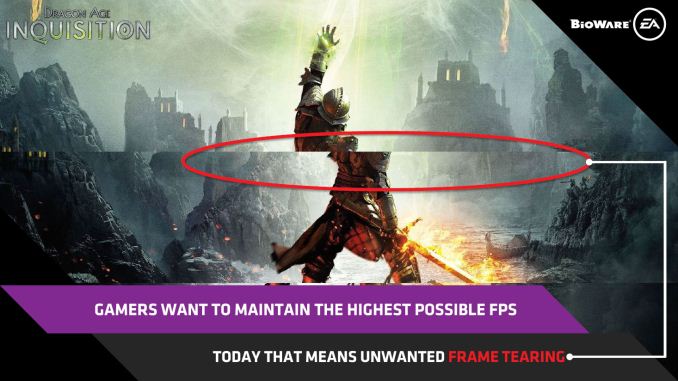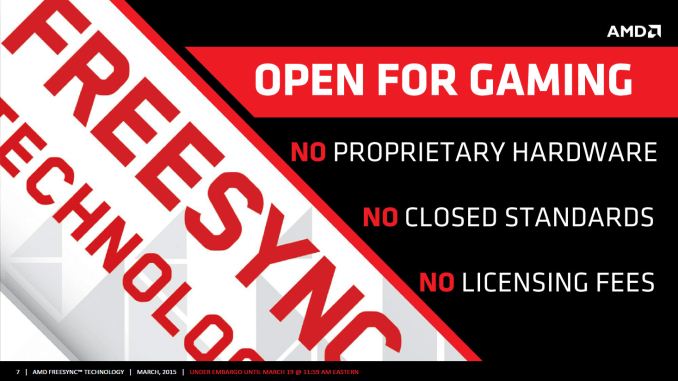The AMD FreeSync Review
by Jarred Walton on March 19, 2015 12:00 PM EST
Introduction to FreeSync and Adaptive Sync
The first time anyone talked about adaptive refresh rates for monitors – specifically applying the technique to gaming – was when NVIDIA demoed G-SYNC back in October 2013. The idea seemed so logical that I had to wonder why no one had tried to do it before. Certainly there are hurdles to overcome, e.g. what to do when the frame rate is too low, or too high; getting a panel that can handle adaptive refresh rates; supporting the feature in the graphics drivers. Still, it was an idea that made a lot of sense.
The impetus behind adaptive refresh is to overcome visual artifacts and stutter cause by the normal way of updating the screen. Briefly, the display is updated with new content from the graphics card at set intervals, typically 60 times per second. While that’s fine for normal applications, when it comes to games there are often cases where a new frame isn’t ready in time, causing a stall or stutter in rendering. Alternatively, the screen can be updated as soon as a new frame is ready, but that often results in tearing – where one part of the screen has the previous frame on top and the bottom part has the next frame (or frames in some cases).
Neither input lag/stutter nor image tearing are desirable, so NVIDIA set about creating a solution: G-SYNC. Perhaps the most difficult aspect for NVIDIA wasn’t creating the core technology but rather getting display partners to create and sell what would ultimately be a niche product – G-SYNC requires an NVIDIA GPU, so that rules out a large chunk of the market. Not surprisingly, the result was that G-SYNC took a bit of time to reach the market as a mature solution, with the first displays that supported the feature requiring modification by the end user.
Over the past year we’ve seen more G-SYNC displays ship that no longer require user modification, which is great, but pricing of the displays so far has been quite high. At present the least expensive G-SYNC displays are 1080p144 models that start at $450; similar displays without G-SYNC cost about $200 less. Higher spec displays like the 1440p144 ASUS ROG Swift cost $759 compared to other WQHD displays (albeit not 120/144Hz capable) that start at less than $400. And finally, 4Kp60 displays without G-SYNC cost $400-$500 whereas the 4Kp60 Acer XB280HK will set you back $750.
When AMD demonstrated their alternative adaptive refresh rate technology and cleverly called it FreeSync, it was a clear jab at the added cost of G-SYNC displays. As with G-SYNC, it has taken some time from the initial announcement to actual shipping hardware, but AMD has worked with the VESA group to implement FreeSync as an open standard that’s now part of DisplayPort 1.2a, and they aren’t getting any royalties from the technology. That’s the “Free” part of FreeSync, and while it doesn’t necessarily guarantee that FreeSync enabled displays will cost the same as non-FreeSync displays, the initial pricing looks quite promising.
There may be some additional costs associated with making a FreeSync display, though mostly these costs come in the way of using higher quality components. The major scaler companies – Realtek, Novatek, and MStar – have all built FreeSync (DisplayPort Adaptive Sync) into their latest products, and since most displays require a scaler anyway there’s no significant price increase. But if you compare a FreeSync 1440p144 display to a “normal” 1440p60 display of similar quality, the support for higher refresh rates inherently increases the price. So let’s look at what’s officially announced right now before we continue.













350 Comments
View All Comments
chizow - Friday, March 20, 2015 - link
Yeah np, 2nd paragraph after the CCC Picture, it clearly states FreeSync panels begin exhibiting ghosting bleow 60Hz.https://translate.google.com/translate?sl=auto&...
You can thank me later for saving you $500+ on a 1st Gen FreeSync panel with ghosting problems that would frankly make it unusable to most.
I am sure we will see more reviews once reviewers actually get samples they can keep and aren't forced to use in AMD's controlled test environment...
silverblue - Saturday, March 21, 2015 - link
I said plural only because you implied it. More links still required.chizow - Saturday, March 21, 2015 - link
You can use google just as well as I can, I am sure. 2 links are plenty, especially when they actually give photo evidence of the problem.chizow - Monday, March 23, 2015 - link
Another confirmation of the problem from Forbes, with quotes from Petersen:http://www.forbes.com/sites/jasonevangelho/2015/03...
The fact Jarred and AT not only missed this, but have actively made excuses/denied it is pretty appalling as more and more reviewers are making note of the ghosting and flickering problems with FreeSync.
anubis44 - Tuesday, March 24, 2015 - link
@chizow: "Read some actual reviews that clearly show right now FreeSync is the inferior solution."You mean, as opposed to all the 'virtual' reviews we've been reading that all say the same thing: that FreeSync does exactly what G-Sync does, except for free? Clearly, a green goblin lover like yourself must respect techreport.com, a blatantly pro-nVidia website plain and simple, and even their response to FreeSync? I quote Scott Wasson:
"Now, I have only had a few hours with the BenQ XL2730Z (our review sample arrived yesterday afternoon), but my first impressions are just this: AMD has done it. They've replicated that sense of buttery smooth animation that a fast G-Sync display will get you, and they've done it in a way that squeezes the extra costs out of the monitors. This is a very good thing."
I'll repeat that operative part of the quote so you can't possibly overlook or ignore it. AMD has "DONE IT. They've REPLICATED THAT SENSE OF BUTTERY SMOOTH ANIMATION that a fast G-Sync display will get you, and they've done it in a way that SQUEEZES THE EXTRA COSTS OUT OF THE MONITORS."
This is all that the vast legions of gamers are going to care about: same buttery smooth performance, less cost. QED.
chizow - Tuesday, March 24, 2015 - link
Yeah, they are virtual reviews, done in controlled test environments in a limited period of time just as noted in that review. Now that actual live samples are coming in however, a LOT of problems are creeping up outside of the controlled test environments.And before you attack the author's credibility, as I'm sure you will, keep in mind this guy has been a huge AMD advocate in the past:
http://www.forbes.com/sites/jasonevangelho/2015/03...
"Note to readers: I have seen this firsthand on the Acer FreeSync monitor I’m reviewing, and PC Perspective noticed it with 2 additional FreeSync monitors, the BenQ XL2730Z and LG 34UM67. To illustrate the problem they recorded the aforementioned monitors running AMD’s Windmill demo, as well as the same demo running on a G-Sync enabled Asus ROG Swift. Ignore the stuttering you see (this is a result of recording at high speed) and pay attention to the trailing lines, or ghosting. I agree that it’s jarring by comparison."
anubis44 - Tuesday, March 24, 2015 - link
@maximumGPU: Oh, but chizow DOES believe it. He believes that the green goblin on the box is the hallmark of quality, and that nVidia NEVER makes any mistakes, NEVER rips off its customers, and NEVER cheats or lies, or acts deceptively, because 'it's all business'. In other words, he's a sociopath. He BELIEVES G-Sync MUST be better than FreeSync because there's a green goblin-labelled chip in the G-Sync monitor that MUST be doing SOMETHING the FreeSync monitor just cannot do. It just HAS to be better, because he PAID for it. LOLchizow - Tuesday, March 24, 2015 - link
Who cares about all that noise? They still offer the best product at any given price point if you can afford a slightly better product. Only sycophants like you go into the stupid and inane morality of it, same way you begrudge Intel for putting their boot to AMD's neck in the CPU market.Buy what gives you the best product for your money and needs, who cares about the rest.
medi03 - Thursday, March 19, 2015 - link
GSync is a shameless attempt to ban competition.AMD couldn't use it even if it would PAY for it.
On the contrary, FreeSync, being VESA standard, can be freely used by any GPU manufacturer, including Intel and nVidia.
Frenetic Pony - Thursday, March 19, 2015 - link
It's adaptive sync but worse in every way. What is possibly good about it?